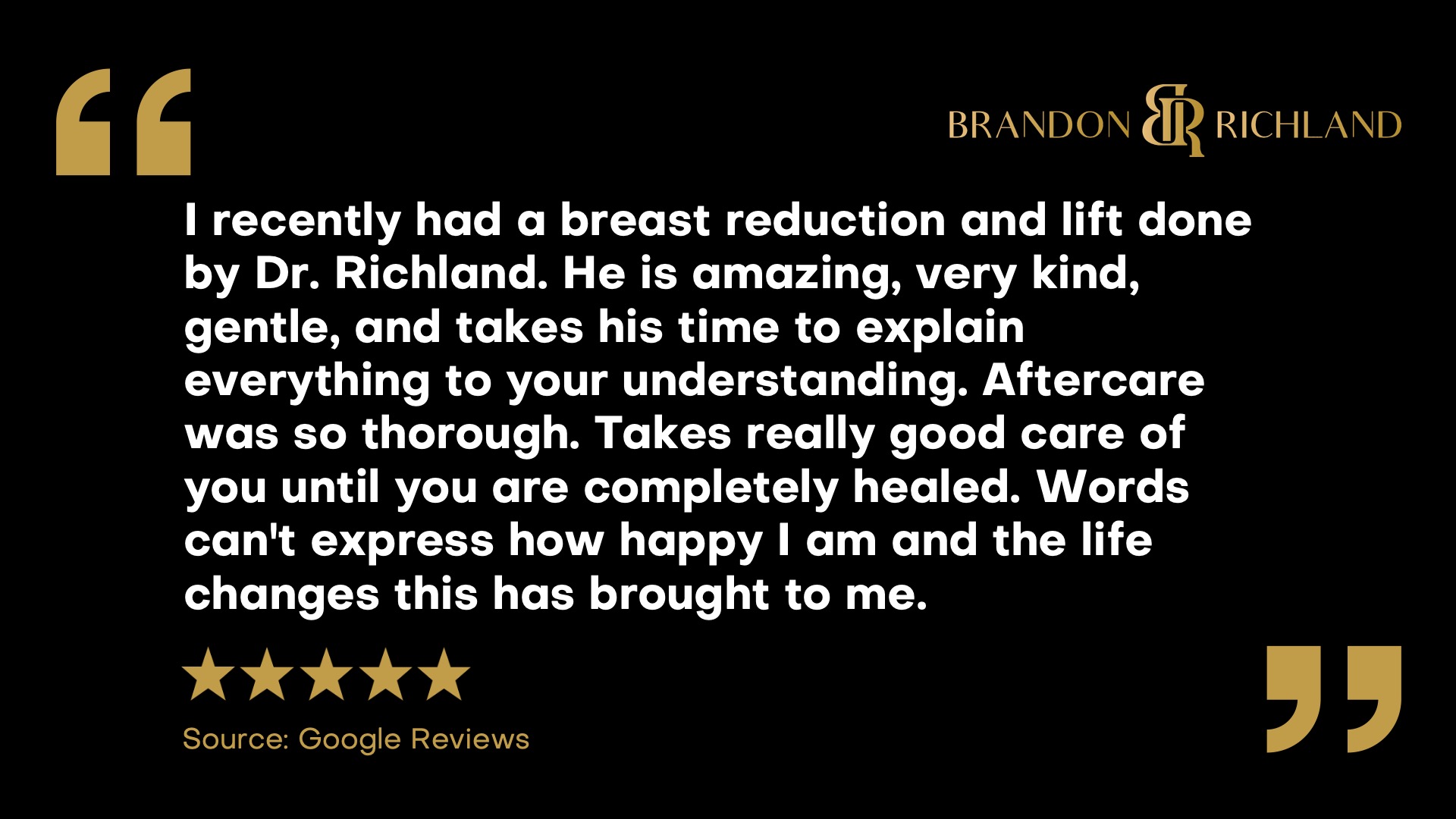Published by Dr. Brandon Richland, MD

“I recently had a breast reduction and lift done by Dr. Richland. He is amazing, very kind, gentle, and takes his time to explain everything to your understanding. Aftercare was so thorough. Takes really good care of you until you are completely healed. Words can’t express how happy I am and the life changes this has brought to me.”
Read the full Google Review here.
Understanding Breast Lifts and Reductions
Breast lifts and reductions are surgical procedures that modify breast shape and size for improved comfort and aesthetics. Each targets distinct concerns and delivers specific benefits to the patient.
Differences Between Breast Lift and Breast Reduction
A breast lift, or mastopexy, primarily addresses sagging skin and aims to raise and firm the breasts by removing excess skin and tightening the surrounding tissue. In contrast, breast reduction, or reduction mammaplasty, focuses on reducing the overall breast size by removing fat, breast tissue, and skin to alleviate discomfort from overly large breasts. During a breast lift, the nipple and areola may be repositioned or resized to fit the newly shaped breast, while reductions may also involve reshaping the areola.
Benefits of Breast Lift and Reduction
Both procedures can significantly increase a patient’s quality of life. Benefits of a breast lift include an enhanced breast contour and more youthful position. For breast reduction, reduced back, neck, and shoulder pain, as well as the potential ease in physical activity, are considerable advantages. Additionally, these surgeries can lead to:
- Improved breast symmetry
- Enhanced clothing fit
- Less skin irritation beneath the breast crease
Ideal Candidates for Procedures
Candidates for a breast lift typically wish to correct sagging due to age, weight fluctuations, or breastfeeding, with the primary goal not being a change in size. For breast reduction, ideal candidates may experience discomfort or limitations in activity because of large breasts and often have indentations from bra straps, persistent back pain, or other related physical symptoms. A consultation with a qualified plastic surgeon is critical for anyone considering these procedures. Good candidates should also be non-smokers in good general health and have realistic expectations about the outcomes, including the potential presence of scars.
The Procedure: Step by Step
The following steps provide a detailed overview of the breast lift and breast reduction surgeries, designed to give patients a clear understanding of what to expect before, during, and after these procedures.
Consultation and Planning
Before any surgical procedure, a consultation with a board-certified plastic surgeon is essential. During this time, patients discuss their goals and concerns. The surgeon reviews the patient’s medical history, including any previous mammograms, and advises on the best course of action. Weight loss history and any plans for future weight loss are considered, as they can affect the outcome of the surgery. Decisions regarding anesthesia type are made at this stage, with most procedures involving general anesthesia to ensure patient comfort.
Breast Lift Surgery Steps
- Anesthesia: The patient is typically given general anesthesia.
- Incisions: A pattern of incisions, which may vary depending on the degree of lift needed, is made. Common patterns include around the areolas, extending downwards, and sometimes along the breast crease.
- Reshaping:
- Excess skin is removed.
- The nipple and areola are repositioned to a more youthful height.
- If necessary, the size of the areola may be reduced.
- Closing Incisions: The cuts are closed which may result in scarring along the lines of incision.
- Recovery: A surgical bra may be applied to minimize swelling. The patient will be monitored for any immediate bleeding or bruising.
Breast Reduction Surgery Steps
- Anesthesia: Administering general anesthesia ensures the patient is comfortable during the procedure.
- Incisions: The surgeon makes incisions that often follow a similar pattern to those of a mastopexy, or breast lift.
- Removal of Tissue:
- Through these incisions, fatty tissue and excess skin are removed.
- Liposuction may be used to aid the removal of fatty tissue.
- Reshaping:
- The breast is reshaped, often including reduction of the areolas in size.
- Nipples may be repositioned.
- Closing Incisions: The incisions are sutured. The new, smaller breast size may help to alleviate discomfort and enhance body image.
- Recovery: Immediate aftercare involves wearing a surgical bra to support the breasts and reduce swelling. The patient needs to monitor for signs of infection or excessive bleeding.
Recovery and Aftercare
Recovery from breast lift and reduction surgeries is a critical phase that requires diligent care for optimal healing and results. Appropriate aftercare ensures minimized risks and contributes to the long-term success of the surgery.
Immediate Post-Operative Care
Immediately following breast lift or reduction surgery, patients are typically fitted with a surgical bra that supports the breasts and helps minimize swelling. The use of gauze and drainage tubes may be necessary to manage excess fluid accumulation. They should follow their surgeon’s instructions regarding medications, which often include anti-inflammatory drugs to manage pain and potentially antibiotics to prevent infection.
Post-Operative Requirement
Surgical Bra
Description: Helps support the breasts and manage swelling.
Gauze and Bandages
Description: Used to cover incisions, absorb fluids, and aid the healing process.
Drainage Tubes
Description: These may be placed temporarily to remove excess fluid.
Medications
Description: Prescribed to manage pain and prevent infections.
Patients are advised to avoid strenuous activities and heavy lifting. They should practice smoking cessation as smoking can impede the healing process. Rest is recommended to enhance recovery.
Long-Term Care and Maintenance
Long-term care following a breast lift or reduction surgery involves maintaining a stable weight to preserve the natural look and improved posture. Significant weight fluctuations can affect the appearance of the breasts. An appropriately supportive bra should be worn during physical activities to prevent sagging breasts and maintain results. Exercise and a balanced diet contribute to overall health and help maintain results.
Long-Term Care Aspect
Weight Stability
Importance: Helps maintain surgical results and breast appearance.
Supportive Clothing
Importance: Prevents additional sagging or stretching.
Healthy Lifestyle
Importance: Contributes to long-term outcome success.
Patients contemplating pregnancy after surgery need to consult with their surgeon as changes in breast size during and after pregnancy can alter the results.
Risks and Possible Complications
Like any plastic surgery, both breast lift and reduction carry the possibility of risks and complications. Potential issues may include scarring, changes in nipple or breast sensation, infection, or difficulties with breastfeeding. Persistent skin irritation beneath the breast fold is generally reduced after surgery. However, patients should report any signs of complications to their surgeon immediately for timely management.
Complications
Infection
Signs or Symptoms: Redness, fever, discharge, or unusual pain.
Changes in Sensation
Signs or Symptoms: Loss of sensation or heightened sensitivity.
Scarring
Signs or Symptoms: Excessive thick or raised scar tissue.
Maintaining open communication with the surgical team is crucial for addressing potential risks.
Results and Expectations
The goal of breast lift and reduction surgeries is typically to alleviate issues such as excess breast tissue, back pain, shoulder pain, and improve self-confidence. Patients can expect relief from physical discomfort caused by excess fat and glandular tissue and a more youthful breast profile. While results are intended to be long-lasting, gravity and aging will eventually cause some changes. Post-surgical confidence often improves along with the enhanced appearance and posture.
Expectations
Alleviated Discomfort
Outcomes: Reduction in back and shoulder pain.
Enhanced Appearance
Outcomes: More proportionate and youthful breast profile.
Improved Self-Confidence
Outcomes: Positive impact on overall self-image.
Patients are encouraged to maintain realistic expectations and understand that it can take months for swelling to completely subside and scars to fade.
Schedule Your First-Class Cosmetic Consultation with Dr. Brandon Richland, MD
Contact Dr. Richland today by visiting RichlandMD.com, scheduling a cosmetic consultation, or by calling 714-844-0398 or 949-997-2958 directly.











